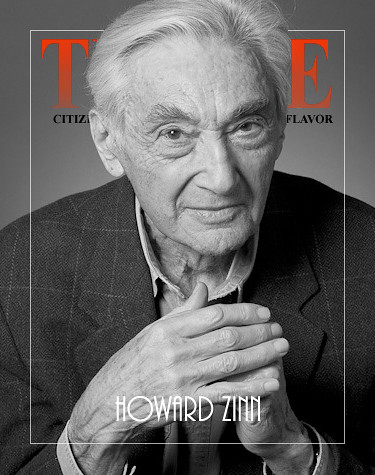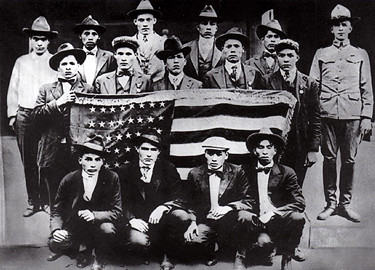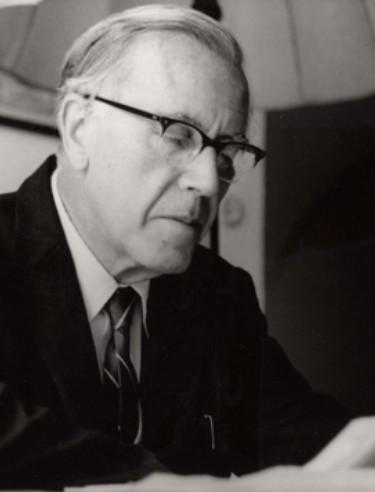
Volume XV, Issue XIa
The Problem of Original Zinn
Howard Zinn’s One Sided View of History
Who is the most influential historian in America? Could it be Pulitzer Prize winners Arthur Schlesinger, Jr. or Joseph Ellis or David McCullough, whose scholarly works have reached a broad literary public? The answer is none of the above. The accolade belongs instead to the unreconstructed, anti-American Marxist Howard Zinn, whose cartoon anti-history of the United States is still selling 128,000 copies a year twenty years after its original publication. Many of those copies are assigned readings for courses in colleges and high schools taught by leftist disciples of their radical mentor.” – Daniel J. Flynn. Howard Zinn, widely hailed as a ‘historian’ once stated “Objectivity is impossible, and it is also undesirable. That is, if it were possible it would be undesirable, because if you have any kind of a social aim, if you think history should serve society in some way; should serve the progress of the human race; should serve justice in some way, then it requires that you make your selection on the basis of what you think will advance causes of humanity.” And so it goes that millions of young minds are being selectively fed Zinn’s view of history which highlights the sins of our great nation while largely ignoring her noble beginnings and aspirations. History according to Zinn must serve a “a social aim” other than the preservation or interpretation of a historical record. A People’s History of the United States, Howard Zinn’s 776 page book attempts to do just that.
To be fair, Zinn initially set out to round out our view of history as he sought to accurately portray the injustice of slavery and the ill treatment of Native Americans. The problem is that he selectively ignores much of the nobleness of this great country in the process as he views history selectively through his own Marxist lens. History, done objectively, is messy. The problem with Zinn’s self-proclaimed mission and methodology is that he descends quickly into the very selectivity in presentation he criticizes in tomes of ‘Manifest Destiny.’ A good historian has to be comfortable with a mess and contradictions. We need to see the noble aspirations of a very flawed humanity in all their realness. We need to see how Washington, Jefferson and Adams hammered out upon the principles of Locke a great recognition of human rights. We need to see how that became the basis for the great arguments that eventually rendered slavery unacceptable. We need to see how unscrupulous men twisted law and government to defraud the Cherokee out of their lands – but we should go to the source – read the Trail of Tears and see how the Moravian Christian Cherokee were massacred by unscrupulous men. The American Civil War needs to be similarly visited. Now we are told we must remove the statues of the “bad guys” and not honor men like Lee. But we need to look at the lives of men like Lee, who struggled with the moral dilemmas before him. After the war, Lee turned down lucrative offers and instead became president of a small struggling Washington College in Lexington, Virginia, dedicating his life to the education of young people. The “good guys” who “won” the Civil War – many of them went on to be the pony soldiers who, using the same vicious pattern of destruction they had employed against Southern cities, would destroy the Plains Nations of the West.
Fast-forward to World War II and you will see Navajo Marines use their native language as a code for communicating over the radio. The Japanese could not crack this code. If you look at the Marine Memorial in Arlington, one man among the men planting the flag on Iwo Jima is a Nez-pierce. Ira Hayes is the figure farthest from the flagpole with both hands reaching up. His inclusion in the memorial is because it is where he actually was standing in the famous photograph upon which the sculpture is based. His inclusion salutes the many Native Americans who have honorably served in our nation’s armed forces. Somehow Zinn fails to recognize the amazing nation built on the contributions of so many – and that her founding principles and rule of law just might have something to do with the advances that have been made in the way of human liberties and justice. Instead, Zinn looks at Communist China and sees “the closest thing, in the long history of that ancient country, to a people’s government, independent of outside control.” Somehow he is able to ignore the bloody ‘Cultural Revolution’ as he does so. Likewise, the Nicaraguan Sandinistas represent the people in Zinn’s mind while the Contras (though they were supported greatly when the country had open elections) are somehow not at all representative. Flynn continues “If you’ve read Marx, there’s really no reason to read Howard Zinn. The first line of The Communist Manifesto provides the single-bullet theory of history that provides Zinn with his narrative thread— “The history of all hitherto existing societies is the history of class struggle.” It is the all-purpose explanation of every subject that Zinn covers. On other hand, why study history when theory has all the answers?”

The use of Native American languages for radio transmissions was actually developed by Cherokee and Choctow coders during World War I. Shown here are a group of Choctow coders.
In Zinn’s world, class struggle is further defined as greed on the part of the ‘upper class’ and the struggle against it is always noble. Thus you find in Zinn a disturbing ability to be comfortable with the sins of the ‘oppressed’ while he cannot see nobility on the part of those he sees as the ‘oppressors.’ While Zinn is entitled to write his thesis, American academics must see it as a footnote, not a complete rendition. We need to learn how to see the big picture again. We are remiss if we exclude parts of the story that trouble our attempt to explain it. We need to write polemics but we need to identify them as such. We do no one a favor by simplistic rendition of complex issues. A good example might be the recent controversy over Colin Kaepernick and the kneeling during the national anthem. Kaepernick originally said he took a knee in protest over police killings of African Americans. Initially Kaepernick had planned to sit during the anthem but Army Special Forces veteran Nate Boyer convinced him to take a knee instead. In 2016 Kaepernick had this exchange with a reporter:
Reporter: “So many people see the flag as a symbol of the military. How do you view it and what do you say to those people?”
Kaepernick: “I have great respect for the men and women that have fought for this country. I have family, I have friends that have gone and fought for this country. And they fight for freedom, they fight for the people, they fight for liberty and justice, for everyone. That’s not happening. People are dying in vain because this country isn’t holding their end of the bargain up, as far as giving freedom and justice, liberty to everybody. That’s something that’s not happening. I’ve seen videos, I’ve seen circumstances where men and women that have been in the military have come back and been treated unjustly by the country they have fought for, and have been murdered by the country they fought for, on our land. That’s not right.”
The First Amendment guarantees him the right to say this, and his point is worth hearing, but the NFL and the teams have the right to impose a ‘code of conduct’ during the game for which players are paid millions of dollars to play. Tim Tebow, the famous Bronco’s quarterback used his position as a player to talk about his Faith. He was criticized for kneeling in prayer on the field at times. During his college days he sometimes had Scripture messages painted in his eye black. An NFL rule prohibited that from continuing. It is worth noting that perhaps Tebow’s biggest and most lasting influence was in the work he did for kids in need. His Tebow Foundation raises millions for children and his ‘Night to Shine’ program gives dignity to young people with special needs. Kaepernick, for his part, has donated suits to young men who have left prison who need them for job interviews. He also has been known to volunteer his time to DREAM, an East Harlem Charter School. Colin Kaepernick, like most of us, would appear to be a bit more complex than we give him credit for. Still, that is not what he is best known for. The protest goes on as more and more players refuse to stand for the anthem and the discussion is lost. Steven Malanga writes: “It’s often said that trends in professional sports mirror the larger society, and certainly the growing distance between increasingly rich players—“tattooed millionaires,” to some—and their fans reflects the same kind of division that drove millions of blue-collar voters to Trump. Once upon a time, professional athletes not only came out of working-class, scrappy neighborhoods, but they also pretty much stayed working class their entire lives. Until as recently as the late 1960s, NFL lineman worked construction or loaded trucks in the offseason to pay their bills. Players with a college degree traded on their celebrity status to sell stocks or insurance. (The policy my mother cashed in when my father died was sold to him in the early 1960s by a retired New York Giants player). Many of today’s players, by contrast, live in a world of ostentatious homes, fast cars, and red-carpet celebrity appearances, far from the struggles of those whose support pays their salaries. These players have deemed themselves important enough to impose their political views on ordinary fans watching sports as a respite from life’s daily grind.”
Thus Malanga correctly identifies the absurdity of rich men who live rich lives becoming the spokespeople for the oppressed poor.“I’ve seen videos” is not the same as living through the horrible injustices that Daddy King and Martin Luther King saw firsthand in their day-to-day experience. Kaepernick was getting royalty checks from NIKE before he became the face of their latest advertising campaign. To some it seems he’s making a lot of money now without having to work at football. What, you might ask, is the ‘everything’ he is sacrificing. NIKE shoes are produced overseas in factories where the workers (predominantly women) earn 20 cents an hour in sweatshop conditions. NIKE shoes are expensive and young minority kids tend to buy them (old white guys tend to buy New Balance shoes, who’s leadership came out for Trump recently). Thus I see more ‘Marketing’ than ‘Social Conscience’ in the so-called ‘Activism’ of selling shoes, on both sides. As for me, I’m more comfortable with a hero like Dietrich von Hildebrand. Who, you rightfully ask, is Dietrich von Hildebrand? Well, I’m glad you asked! His biography states:
Dietrich von Hildebrand (1889-1977), was born in Florence, was the son of renowned German sculptor Adolf von Hildebrand. A leading student of the philosophers Edmund Husserl and Max Scheler, he took up the “great questions” – about truth, freedom, conscience, community, love, beauty – with a freshness that allowed him to break new ground, especially in ethics, but also in epistemology, social philosophy, and aesthetics. His conversion to Catholicism in 1914 was the decisive turning point of his life and the impetus for important religious works. His opposition to Hitler and Nazism was so outspoken that he was forced to flee Germany in 1933, and later across Europe, finally settling in New York City in 1940, where he taught at Fordham University until 1960. He was the author of dozens of books, both in German and English. He was a major forerunner of Vatican II through his seminal writings on marriage, on Christian philosophy, and on the evil of anti-Semitism.”
Adolph Hitler, the most evil man of the Twentieth Century considered him his greatest enemy. That is a signature honor. Hildebrand was forced to flee Europe during the Shoah and he came to America. Yeah, he really stood for something that would have cost him everything. He became a lecturer at Fordham University and influenced generations who followed him.
Thus it may be seen that history has many more such men and women we should look to for inspiration. That is why we must present it in all its fullness to future generations. Do do less is to render to them a great disservice as it leaves them to face the challenges of life in the darkness of deliberately manicured ignorance.

Dietrich von Hildebrand. Integrated Catholic Life.
